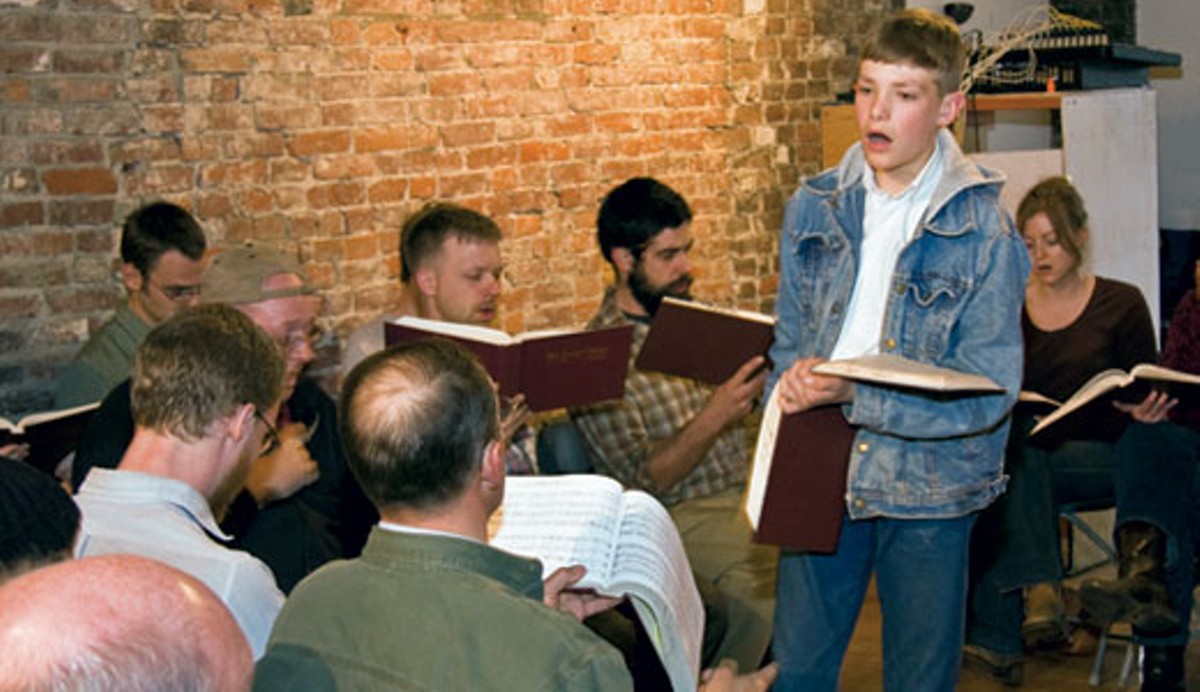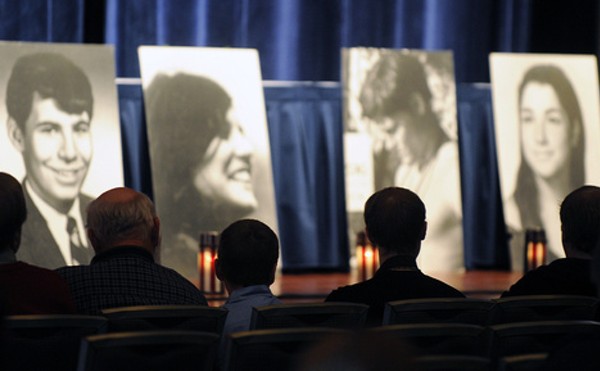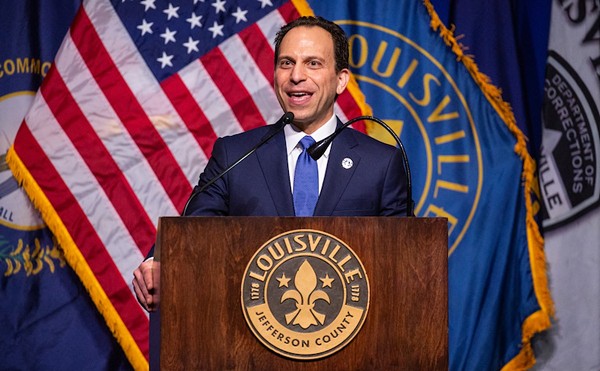We arrived late to the Ohio Sacred Harp Convention, just outside of Cincinnati. Braced against the February chill we approached the Little Red School House, where the breath of 120 singers hung on the windows as drops of condensation, a peculiar visual relic of the human voice.
The dispersed harmonies of the voices inside were clear on our approach, and as the door opened, the incredible volume and ecstatic polyphony of the Sacred Harp was arresting, wrapping around us like the smoke of an ill-contained campfire.
That we entered into a single-room schoolhouse couldn’t have been more appropriate. We were literally the new kids at school, uncertain of protocol or even where to sit. We were eager to fit in. As we registered and wrote out nametags we took in our surroundings: the picture of George Washington over the door; the perfect cursive writing demonstrated on a strip of blackboard that ran around the vaulted room; a few members in simple Mennonite dress; the huge arched windows looking out onto several pastoral acres. One could have been convinced that nothing in that room, including the sounds of the voices gathered, had changed in 200 years.
We were each loaned a large, red oblong book with the words “The Sacred Harp” embossed in simple gold leaf text. We took our seats and sang, all together.
The Sacred Harp is a songbook that was first compiled and published by B.F. White and E.J. King in 1844. The folk-hymns gathered between its covers were written by dozens of authors from periods ranging from the earliest years of the 1700s through the time of its most recent revision, in 1991. The songs use a unique and simple sight-reading system with different shapes for the notes in the scale. The hymns were composed for unaccompanied singers divided into four groups: treble, tenor, alto and bass.
The book is now synonymous with an entire musical tradition whose roots run from the current and most potent form — as Southern folk music — back through the earliest days of American musical composition, and then even further, to 17th century Europe. It is, according to its devotees, the living example of the first truly indigenous form of Colonial American music, sung without interruption since the beginning of this country.
‘O come loud anthems let us sing’
Upon hearing the music of the Sacred Harp for the first time, people invariably think two things:
1) I’ve never heard anything like this in my life.
2) These people are singing really loudly.
It is full-throated, bombastic music that was written more for the benefit of the singers than listeners (who ought to be singing anyway, the thinking goes). It is simultaneously thunderous, joyful, brash and unsettling. There is no instrumental accompaniment, and the singers belt as loudly as possible without hurting themselves. At first blush it sounds like the complicated melodic utterances of people singing in tongues — the singers intone only the syllables Fa, So, La and Mi, in four separate but interwoven melodies, before they finally sing the words to the tune in English.
What was previously a melodic but unintelligible dust-up between rival vowel sounds suddenly reveals itself as the unified agreement of four beautiful, if primitive counter-melodies, all joined in wonder and praise.
I have sung the music at this point, when the voices coalesce in word, rhythm and song. It is as though giant earplugs have been removed from your chest cavity, and there all the voices resound together as different strings of one enormous holy instrument.
The bizarre and beautiful sound of the Sacred Harp is the result of numerous and varied elements that are only complicated if you think about them for too long. One of the most compelling and easy to hear is the dependence on counter-melodies. The four parts sung in a given Sacred Harp song are not exactly harmonies, in the strictest sense.
Instead of writing one interesting and catchy melody, with three supporting and predictable harmonies, composers in the Sacred Harp opted to make each part as interesting and enjoyable to sing as possible; thus, in the lion’s share of the music, the parts were written as four distinct, simultaneously occurring counter-melodies. It was this unorthodox, contrapuntal and homegrown sound of the four parts constantly crossing over and weaving in and out of one another like starlings in flight that eventually drove the European musical elite of the “Better Music Movement” — a self-appointed group that urged more orthodoxy in composition — to the point of pulling out their hair.
In the literature about Sacred Harp singing, and in discussions with the singers, some derivation of the same description comes up constantly: It’s simple music for simple people. It is music that doesn’t need or want an audience but only more participants. Because there will be varying degrees of familiarity with the music and vocal competence at every Sacred Harp singing — it is democratic and invites the novice and expert alike — it is also imperfect, and will always be that.
In the unwavering commitment to rough edges, Sacred Harp singers find the sense of communion shared by underdogs the world over; I think I can safely say that not one Sacred Harp singer in 100 wishes he was singing in the Mormon Tabernacle Choir.
‘Present joys’
The gleeful disregard of Sacred Harp composers and singers for mainstream, topical music is at the core of the movement itself. Its similarities to the DIY ethic of the punk rock music that I grew up with are obvious. The composers and singers of both had limited orthodox musical training, preferred exaggerated rhythm and constant, extreme volume to more refined senses of compositional dynamics, and the songs of both — with harsh and even violent imagery — refuse to cater to the inoffensive, maudlin sensibilities of more formally accepted genres.
In this light it seems somehow natural that the past decade has seen greater popular interest in the Sacred Harp in general, and by a younger generation of singers in particular.
The More the Merrier Shape Note Singers, a Sacred Harp group recently founded by Louisville filmmaker and musician Timothy Morton, hold their singings at a music venue called Skull Alley on East Broadway. I sing with them when I can. Recently, during a break between tunes, I took a call from an old friend in Minneapolis who needed a place to stay on his way through town. In the course of our conversation I asked what he had been doing lately, to which he replied:
“I’ve been learning how to sing this amazing form of Southern a cappella choral music called Sacred Harp. I just now left practice. You should really check it out sometime — you’d totally love it.”
Apparently it’s happening everywhere.
The documentary “Awake My Soul,” which aired on some 170 PBS stations last year and garnered national attention, has helped facilitate the broadened interest.
Matt Hinton and his wife Erica are responsible for the film. He told me he meets singers regularly who trace their initial interest to his documentary.
I told Hinton that, second to the beauty of the sounds and the community I felt in singing the music, I was attracted to the Sacred Harp because of a perceived authenticity it seemed to provide, that it appealed to a need I felt to be a part of a specific and legitimate history.
Hinton said people find comfort in the music because it allows them to be serious in an era when popular culture seems dismissive, even antagonistic toward that need. The shared experience of group singing provides a space not cloaked in irony, where a person is given permission to be thoughtful and sincere.
When I asked him if he ever had concerns about secular participation in the music, Hinton — a religion professor by trade, and a Presbyterian, and a singer — said that he only hoped people would “take the texts of the Sacred Harp seriously, and not willfully navigate around their message without some self-interrogation.”
‘New Britain (Amazing Grace)’
In our most rudimentary history lessons we’re taught that Colonial America was home to a patchwork of political radicals, religious dissenters and tax evaders who uprooted themselves from tyranny in favor of a greater degree of self-expression. In their drive to separate themselves from all things Continental, the colonists also turned their backs on the religious music of Europe, and by the first decades of the 1700s, singing — in churches that had any music at all — had declined into a state of stagnation. By some estimates, it had become an altogether uninspired and unimpressive affair.
The church music of the time existed largely without songbooks, a form of call-and-response intoning of the psalms called Lining Out, or psalm singing, in which the precentor would “sing” a passage and the congregation would, with no harmony whatsoever, slowly regurgitate the same words, maybe using the same melody and rhythm, maybe not.
A widespread desire for a more formalized and pleasing singing experience urged along the composition and publication of a new breed of sacred music songbooks, as well as the institution of the New England Singing-School movement. The movement represented a uniquely American hybrid of cultural ingenuity, faith and market-driven opportunism whose mark on American musical history — a swath mown from Boston to Texas and through four centuries — was the immediate predecessor to the Sacred Harp.
The goal of the singing schools was (and continues to be) to teach laypersons of little or no training the basics of music and sight-reading. A semi-professional class of music enthusiasts and composers emerged, writing and teaching hymns using a simple, systematic form of sight-reading based on the European technique of solmization, in which each tone in the musical scale is represented by a syllable.
Unlike the solfege that sounds out the scale in seven syllables — Do, Re, Mi, Fa, So, La, Ti — the Sacred Harp uses only four syllables, repeated thusly: Fa, Sol, La, Fa, Sol, La, Mi, Fa.
In the 1880s, during the final stage of its development, the system was augmented with the addition of the shape-note musical notation. Simply put, the syllables fa, sol, la and mi were each assigned a shape so that sight-reading on the musical staff would be even simpler to learn.
It was called shape-note singing, and it worked.
The singing-schools in New England were no sooner established and thriving before the self-named “Better Music Movement” arose to take issue with the music for precisely the same reasons that the Lining Out of psalms had been derided 75 years before. By the beginning of the 1800s, the boisterous four-part music of the singing schools had lost traction in the Northeast and was ridiculed as “musically unscientific,” coarse and even rude.
Shunned in favor of the tamer choral trends that prefigured the choir music we hear today, the singing masters headed south. There they found their talents welcomed by rural Southerners who were happy to learn the fasolas, and who didn’t share the need of their Northern cousins to keep up with European musical sensibilities. For them, singing to their God was a birthright.
And so it was in the rural South, specifically Georgia and Alabama, where shape-note singing became a real grassroots tradition.
The sense of seclusion that must have been felt by the inhabitants of the rural, horse-drawn South of the early 19th century is difficult to imagine these days, when a car ride through the country is peppered with truck stops, strip malls, satellite dishes and the like. At the time, when most country folk had minimal social interaction outside the family farm, and made it into town for church and for the mail maybe once a month, the promise of communal interaction, singing and shouting at the increasingly popular tent revivals and camp meetings must have been an exciting prospect. It was these interdenominational gatherings that, while wholly and firmly religious affairs, provided a means of secular socializing that was difficult to come by in rural areas.
These meetings, like the famous Cane Ridge Revival of 1801 — which saw upwards of 13,000 attendees — served as something of a Petri dish for the commingling of the shape-note system, extant tunes from the singing-school tradition and folk hymns that settlers had retained from their European roots. The songbooks that preceded the Sacred Harp — like the Missouri Harmony, Southern Harmony, Kentucky Harmony, etc. — document this rapid marriage of new forms with older content.
‘I belong to this band, Hallelujah’
Depending on your perspective, the happy meeting of the Ohio Valley Shape Note Singers and The More the Merrier Shape Note Singers was the result of dumb luck or divine providence.
Local filmmaker and musician Timothy Morton had taken it upon himself to learn shape-note singing, and put together a Sacred Harp group from the ground up. He read all the material he could find online and at the library, at which point he called a dozen or so of his friends, myself included, and together we watched “Awake My Soul,” read some provisional material, listened to some recordings, and took a stab at making the music work. It was about as easy as playing dominoes in the dark, but we made some real headway after easing into the rudiments in several lessons Morton compiled. Still, the group lacked foundation and direction.
As Tim drove down the street one evening he saw a minivan with a vanity plate that read, “FASOLA,” shorthand for the notes in the musical scale. Morton honked, pointing to the plate and motioning for the driver to roll down her window. Tim asked the driver, Pat Meek, if she sang the Sacred Harp. Turns out the van was her husband Bob’s, and he happens to be the founder of the Ohio Valley Shape Note Singers. Pat told Tim to drop him a line.
The two groups started having singings together. Bob Meek became the unwitting master to the new and eager singers; he had all of us singing the four parts as loud as we could in no time flat.
In each successive meeting at Skull Alley, and in the homes of sympathetic friends, more members from the Ohio Valley group, which was founded 22 years ago, came to sing with our fledgling band. Disparate groups with distinct histories, backgrounds, perspectives and voices cross-pollinated for the sake of the song, and for the sense of community fostered so easily in the simple singing of Fasola.
By the time the new singers made it to the Ohio convention at the Little Red School House, news of the upstart group had spread through the tight-knit regional Sacred Harp community. We were greeted with the same grace and genuine curiosity that one would extend to a newly discovered cousin.
Over a bountiful potluck luncheon we bounced around among eager veterans who wanted to welcome us into the fold — and tell us about the rich tradition that we’d been fortunate enough to stumble into. By the end of the day, The More the Merrier singers were being referred to by one and all as “The Lost Tribe of Louisville.”
‘Give me a calm and thankful heart’
The singers of the Sacred Harp arrange themselves in a square with a hollow center. The music of the Sacred Harp is also, in a sense, a closed circuit that has no priority outside of itself. Singers don’t practice or anticipate any distant objective besides the next singing. When they gather their only goal is to sing the pieces.
This was jarring to me at first because it is a distinctly different way of being creative than I, as a songwriter and performer, have known. It is this unambiguous and exceedingly simple attitude toward — and immediate realization of — song that has been so relieving and cathartic to me, and I imagine many others. I don’t think I’ve been in such direct proximity to the creative impulse since I was a child. You just open your mouth and sing. And when the song is over, you sing another — over and again, until it’s time to go home.
The preface of The Sacred Harp asks of the singers to seek old paths and walk therein. I find real comfort in this music, in the notion of the human voice as actually and truly sacred.
There is an amazing power in singing these songs, in creating with a group of other people such a singular sound that compels people to travel sometimes-incredible distances to sing with one another.
“The Memorial Lesson” is a piece chosen by friends and family that is sung in honor of singers from the area who have died since the last convention. Whoever is to lead the “lesson” (which is the same as a saying “song” and harkens to the Sacred Harp’s roots in the Singing Schools) will read the names and eulogize the recently passed before all of the singers join in what is, to say the least, a somber and moving gesture. In these moments the singers mourn not just a friend who is gone, but another singer who has, in their passing, taken with them one string of the Sacred Harp.
Every singing and convention ends with the “Parting of Hands.” The singers turn their books to page 45 and a piece written in 1779 by John Newton called “New Britain” — more recognizable by its common name, “Amazing Grace.” The singers move in opposing concentric circles — singing, smiling and shaking hands, hopefully to meet again soon.
HEAR MORE
Click here to listen to examples of shape-note singing, and to read the author's notes on the songs.






